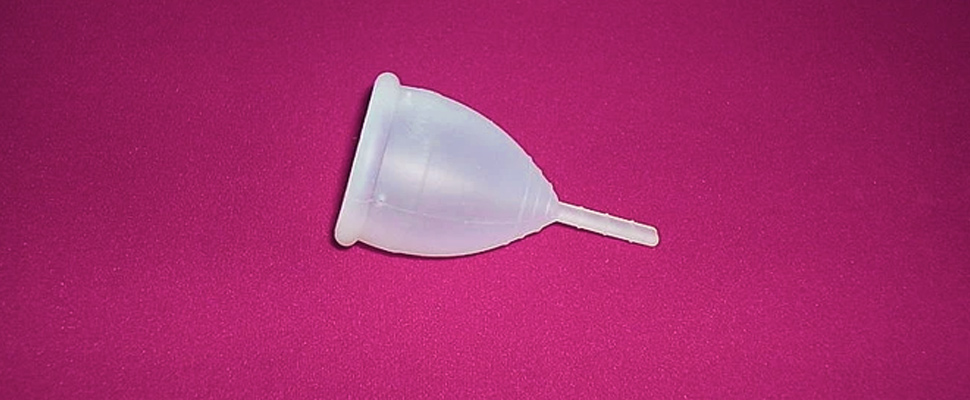A friendly way to bleed: switch to a menstrual cup
Even though they have been around for decades, it's only today that we are starting to love them. Here's why.

Menstrual cup. / Photo: Wikimedia
The Woman Post | Luisa Fernanda Báez Toro
Listen to this article
Leer en español: Una forma amigable de sangrar: cámbiate a la copa menstrual
The patent for the first menstrual cup was issued nearly 100 years ago, as The New York Times states, but the device was not widely embraced because of cultural and religious beliefs and the several taboos about coming in contact with menstrual blood.
It was not until 2016 that the menstrual cup was officially introduced locally through the Ministry of Health and Child as a solution to the rise on the prices of sanitary wear, mostly for women in rural areas who cannot afford regular sanitary wear.
A menstrual cup is a type of reusable feminine hygiene product. It’s a small, flexible, made of rubber or silicone and collects your blood for almost 12 hours.
“Just having access to this reusable product can eliminate some of the struggles girls experience when they can’t leave the house and have to miss school or work because they don’t have sanitary products,” said Dr. Espinal Dr. Mariana Espinal, a resident in obstetrics, gynecology and reproductive sciences at Yale University School of Medicine in a recent paper published in The Lancet Public Health.
In an interview with The Woman Post, Nestor Balcazar Galindo, gynecologist and obstetrician states that "from every point of view it is a good action by women, not only because it ends up being much cheaper than pads or tampons, but because it is much more ecological and much more practical."
As he says, the only "bad thing" is that you have to use it strictly as recommended: buy one of very good quality from a recognizable brand, empty it two or three times a day depending on your flow to prevent infections and wash it supremely well.
Also read: First female mayor of Bogotá makes the corrupt tremble
According to uquora, tampons absorb "everything in your body, not just your menses, which can throw off your pH creating an environment where bacteria thrive". Also, according to a study releaesed by the National Institutes of Health, even though tampons made of synthetic fibers are no longer allowed, "all tampons can cause tiny tears in the vagina, which may provide entry for other chemicals or the toxic shock syndrome toxin."
To figure out the right menstrual cup size for you, you and your doctor should consider: your age, if you have given birth vaginally, the lenght of your cervix, the cup capacity and your period flow, as Health Line explains.
"Smaller menstrual cups are usually recommended for women younger than 30 years old who haven’t delivered vaginally. Larger sizes are often recommended for women who are over 30 years old, have given birth vaginally, or have a heavier period", states the site.
According to The New York Times, the price of a menstrual cup that can last up to 10 years is about US$ 40 in the United States. Since one year’s supply of disposable pads or tampons can cost between US$ 60 and US$ 120, this is a great option.
Your period will not be a problem anymore
Sara Lucia Lizarazo, an environmental engineering student, recognizes in an interview with The Woman Post that moving to more sustainable alternatives is one of the biggest advantages.
“I've been using the cup for almost three years now and I really like it. The tampons and pads did not work for me: it bothered me a lot to change constantly and I did not like the feeling of feeling wet, so before knowing the cup being on my period was always very uncomfortable”, Sara said.
At the time she started thinking about using the cup it was not well known and less in her country, Colombia. “I asked for it in a German brand because they didn't sell them here. I was a virgin and I was very scared that it would hurt or affect me, using it was an effort.”
After about three months she was able to use it well and the period was no longer a problem for her. “With the cup I have done everything: I have gone to the gym, to the pool, I have done yoga. Changing it in public places is complicated but, as it lasts longer than tampons, you just have to organize your time so you can change it at home.”, she concludes.
Also read: Women scientists author fewer invited commentaries in medical journals than men
Here´s how to use it
Using the cup could be scary at first, but try this steps and bleed in a safer and friendly way:
- Make sure your hands are clean before touching your cup.
- The company organicup states in its portal that it is important to keep calm when inserting the cup (even though feeling nervous is natural) because nerves may cause vaginal muscles to tense.
- Try it before having your period. As we already said, getting used to the cup could take some time, so practice before your period days to be prepared and make sure it is correctly put on.
- Find the most comfortable position for you.
- Fold the cup before inserting it into your vagina. One of the most popular methods is the "C fold", which involves folding one side of the cup over the other to form a "C" shape. Once the cup is inside it should "pop" open and you shouldnt feel it. If you do, it was not inserted properly so try again.
- To remove the cup pull gently on the stem until you can reach the bottom of the cup, then pinch the bottom of the cup to release the suction seal. Then all you have to do is remove the cup slowly and empty it
- Rinse it with water and then, after your period is over, put it into boling water for a few minutes.
As OrganiCup co-owner Gitte Dalberg-Larsen told Mirror Online: "We believe no woman should be held back by her body. We believe period products should not contain harmful chemicals nor absorb natural bodily secretions, resulting in infections. Periods should not be the cause of major pollution. And they should never, ever be a source of shame”.





